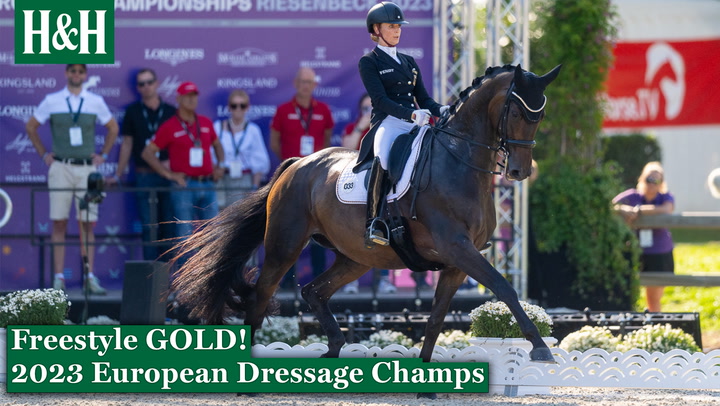A well-ridden give and retake of the reins shows that your horse is capable of maintaining self-carriage and balance without relying on your hands to hold them up. It also tests the rider’s reliance on their hands for control, emphasising the importance of an independent seat and legs.
Think of the movement as a diagnostic tool for judges. A horse on the forehand will stumble or lose its balance when the reins are given. This shows a reliance on the rider’s hands.
 Watch the video
Watch the videoWhereas, a horse that struggles to accept the contact might react by becoming tense or shortening its stride. Furthermore, if a horse is not round over its back, the give and retake can cause it to hollow and raise its head.
The give and retake of the reins is introduced from the earliest levels and continues to be seen in dressage tests up to advanced medium. However, it’s a movement riders often struggle to perform well, with comments like “no give and retake shown” blotting test sheets up and down the country.
What are the judges looking for?
The British Dressage (BD) members’ handbook states that judges are looking for riders to push their hands forward towards the bit, clearly releasing the contact “through showing a loop in the rein from the hand to the bit” before retaking the contact.
It adds that the movement of the hands must be “continuous and achieved over two or three strides” and that the horse must “stay in balance, keeping the same rhythm, level of engagement, suppleness of the back.”
Give and retake is often misinterpreted as allowing the horse to stretch down, but that’s not the case. Rather, the judge wants to see everything remain the same for two to three strides while you release the contact.
A good give-and-retake should be smooth and not rushed.
To ride a good give and retake, the horse should be in balance. This means ensuring the horse is taking their weight on the hindlegs as much as possible, before riding the movement.
“It’s the balance which you can ride them into it that dictates the quality of the movement,” explains Gareth Hughes. “Imagine the beginning of every movement as the approach to a showjumping fence – you have to set the horse up to perform it correctly.”
After showing the give, your horse should look comfortable when you retake the reins, with nothing changing in their way of going.
What not to do
Avoid letting your body tip forward too much. Doing so will push your horse onto their forehand and result in them dropping their head or rushing forward. When releasing the contact, don’t let your reins get too much longer and don’t thrust them forwards.
Instead, give your hand forwards in line with the bit. For most people, straightening your arms is enough to achieve a noticeable loop. However, riders with shorter arms might struggle to show a clear loop without leaning forward slightly.
Also, try not to lift your hands up during the release. This isn’t a release; all it does is change the angle of the contact.
Take care not to ride the give part for too long. Riding it for too many strides increases the chances the horse will become disconnected and lose balance. The best give and retakes are short and sweet – but not rushed.
A helpful tip is to break the movement down into parts, over four or five strides. For example, in stride one you’ll be giving the rein, moving the hand forward. Count out strides two and three – or four for the ambitious – in the give. Then on the last stride of your sequence, smoothly retake.
Practice, practice, practice…
The give-and-retake is not just a test movement, it is also an invaluable training exercise.
“If your horse is in self-carriage you should be able to give and retake the reins without him losing balance, but how many people ever actually do this at home?” asks Carl Hester.
“Incorporating it at home even for three strides at a time will help you see where you are with your training. It also allows your horse to relax in his mouth, helping encourage him to chew the bit and become softer.”
German dressage legend, Christoph Hess agrees. “We want to always open through the throatlash, so the horse is always seeking the bit and takes a steady contact,” he explains. “Especially in tense horses – don’t be afraid to give that rein. When the horse gets more and more open in the neck and the frame, they can start to swing more over the back.”
For particularly tense horses, Micheal Eilberg recommends riding a square and giving and retaking the reins in the corners.
“Don’t give and retake unless you feel you have the horse collected,” he says. “This gives him the opportunity to run away with you and shows him he can. If when you give the reins the horse puts his head up or runs off, try just giving the inside rein quietly, keeping the outside rein to half-halt.”
You may also be interested in…

8 training gems from Carl Hester that could transform your dressage scores

What is a turn on the forehand, and how to ride it correctly

Laura Tomlinson’s top 5 novice dressage training tips that suit all types of horse

Master advanced movements with top tips from Gareth Hughes and Richard Davison

Subscribe to Horse & Hound magazine today – and enjoy unlimited website access all year round
Horse & Hound magazine, out every Thursday, is packed with all the latest news and reports, as well as interviews, specials, nostalgia, vet and training advice. Find how you can enjoy the magazine delivered to your door every week, plus options to upgrade your subscription to access our online service that brings you breaking news and reports as well as other benefits.




